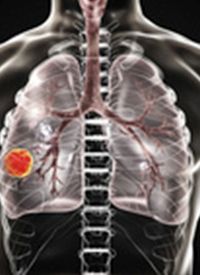Sunvozertinib Generates Responses in Platinum-Pretreated EGFR Exon 20–Mutated NSCLC
Sunvozertinib provided beneficial antitumor activity when used as a second- or later-line treatment in patients with non–small cell lung cancer harboring EGFR exon 20 insertion mutations who received prior platinum-based chemotherapy.

Sunvozertinib (DZD9008) provided beneficial antitumor activity when used as a second- or later-line treatment in patients with non–small cell lung cancer (NSCLC) harboring EGFR exon 20 insertion mutations who received prior platinum-based chemotherapy, according to updated data from the phase 2 WU-KONG6 trial (CTR20211009) presented at the 2022 ESMO Congress.1
Patients treated with sunvozertinib (n = 97) achieved a confirmed objective response rate (ORR) of 59.8% by blinded independent central review. Notably, all confirmed responders had a minimum of 2 post-treatment tumor assessments. Further, patients who presented with baseline brain metastases (n = 31) experienced a confirmed ORR of 48.4% with the agent.
“Clinical activities were observed across a board range of EGFR exon 20 insertion mutation subtypes, regardless of mutation positions,” lead study author Mengzhao Wang, MD, PhD, of the Department of Pulmonary Medicine at the Lung Cancer Center at Peking Union Medical College Hospital, and colleagues, wrote in a poster presentation of the data. “Sunvozertinib demonstrated a comparable safety profile to other EGFR TKIs.”
Sunvozertinib, an irreversible EGFR inhibitor, was designed to target EGFR mutations. The agent was granted a breakthrough therapy designation by both the FDA and China’s National Medical Products Administration based on prior data observed with the agent in the phase 1/2 WU-KONG-1 (NCT03974022) and WU-KONG2 (CTR20192097) studies.2
Additional global studies are evaluating the agent in the second line and beyond for patients with NSCLC harboring EGFR exon 20 insertion mutations, including the WU-KONG6 trial.
The open-label, single-arm, multicenter WU-KONG6 trial enrolled patients with locally advanced or metastatic NSCLC and central laboratory–confirmed EGFR exon 20 insertion mutations who had progressed on or after platinum-based chemotherapy.
Patients received continuous dosing of sunvozertinib at 300 mg daily until disease progression, intolerable adverse effects (AEs), or withdrawn consent.
The primary end point of WU-KONG6 was ORR assessed by blinded independent central review.
Among 97 patients enrolled in WU-KONG6, the median age was 58 years (range, 29-79), 59.8% of patients were female, and all patients were Asian. Additionally, 69% of patients had an ECOG performance status of at least 1. Regarding prior treatment, 49.5% of patients received 1 prior line of therapy, and 50.5% received more than 1 prior line of therapy. Prior therapies consisted of platinum-based chemotherapy (100.0%), anti–PD-1/PD-L1 therapy (34.0%), and an EGFR TKI (25.8%). Thirty-two percent of patients presented with baseline brain metastases.
The efficacy analysis looked at data from 97 patients with platinum-pretreated NSCLC whose tumors harbor EGFR exon 20 insertion mutations and had a data cutoff of July 31, 2022.
Among 71 patients with near loop EGFRexon 20 insertion mutations, sunvozertinib induced an ORR of 62.0%, with a disease control rate of 88.7%. Twenty-four patients with far loop EGFRexon 20 insertion mutations experienced an ORR of 50.0% with the agent, and a disease control rate of 83.3%.
The median duration of response (DOR) among all patients was not yet reached. Notably, the longest DOR reported was more than 9.7 months, and this patient was still receiving and responding to treatment as of the data cutoff.
“A total of 30 subtypes of EGFR exon 20 insertion mutations were enrolled,” the study authors noted. “Antitumor activities were observed regardless of mutation subtypes and positions.”
The safety analysis evaluated 277 patients who had received a minimum of 1 dose of treatment from WU-KONG1, WU-KONG2, and WU-KONG6. Among the 277 safety-evaluable patients, 177 received sunvozertinib at 300 mg.
The most common grade 3 or higher treatment-emergent AEs in patients who received 300 mg of sunvozertinib included diarrhea (7.3%), rash (2.8%), increased blood creatine phosphokinase (13.5%), anemia (3.9%), stomatitis (2.2%), paronychia (1.7%), decreased appetite (1.7%), nausea (1.1%), and vomiting (0.6%). Among patients treated with 300 mg of sunvozertinib, treatment-related AEs led to dose interruption, dose reduction, and treatment discontinuation in 33.1%, 20.2%, and 7.9% of patients, respectively.
Study authors noted that the majority of the reported AEs were mild to moderate in severity, and after supportive care, the AEs were reversed and patients were able to recover.
References
- Wang M, Yang JC-H, Mitchell P, et al. Sunvozertinib for NSCLC patients with EGFR exon 20 insertion mutations: preliminary analysis of WU-KONG6, the first pivotal study. Ann Oncol. 2022;33(suppl 7):S1003-S1004. doi:10.1016/j.annonc.2022.07.1114
- FDA grants breakthrough therapy designation for Dizal Pharmaceutical’s DZD9008 in patients with locally advanced or metastatic non-small cell lung cancer harboring EGFR exon20 insertion. New release. Dizal Pharmaceutical Co. Ltd. January 28, 2022. Accessed September 23, 2022. https://bit.ly/3ulggSf



